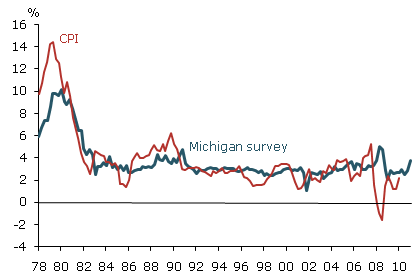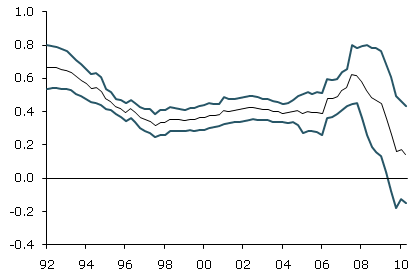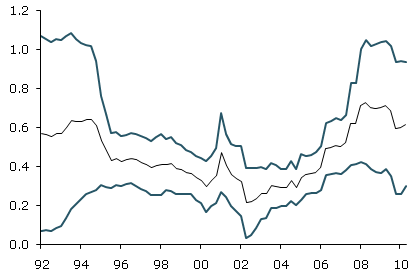The University of Michigan survey of consumers shows that expected inflation has moved up noticeably over the past few months, raising concerns that we may be in for a period of rising inflation. However, the increase in expected inflation likely reflects the excess sensitivity of consumers to food and energy prices. Consistent with this hypothesis, household surveys have not forecast inflation well in recent years, a period of volatile food and energy prices.
According to the Thomson Reuters/University of Michigan survey of consumers, households currently expect inflation to average about 4½% over the next year, up noticeably from 3% at the end of 2010. These results come at a time of surging commodity prices and raise the possibility that inflation might accelerate substantially and even lead to a return of the stagflation of the 1970s.
This Economic Letter argues that the jump in household inflation expectations is a reaction to the recent energy and food price shocks, following a pattern observed after the oil and commodity price shocks in 2008. The data reveal that households are unusually sensitive to changes in these prices and tend to respond by revising their inflation expectations by more than historical relationships warrant. Since commodity price shocks have occurred relatively often in recent years, this excessive sensitivity has meant that household inflation expectations have performed quite badly as forecasts of future inflation.
The survey data
Each month, the University of Michigan’s Survey Research Center assesses consumer sentiment by interviewing a random sample of approximately 500 U.S. households. As part of the survey, respondents are asked to forecast key macroeconomic variables, such as inflation, interest rates, and unemployment. Since 1977, they have been asked how much they expect prices to go up over the next year and the next five to ten years.
Figure 1
Year-ahead actual and expected inflation

Note: Each point on the line labeled “CPI” plots the value of CPI inflation over the next 12 months. Data for expected inflation from the Michigan survey are plotted on the same basis.
Figure 1 shows monthly Michigan survey data for 12-month-ahead inflation expectations and the realized consumer price index (CPI) inflation rate measured on a comparable basis. The last data point plotted for CPI inflation is the value for the first quarter of 2010. It measures actual inflation over the four quarters from the second quarter of 2010 to the first quarter of 2011. Since the late 1970s, the Michigan survey data on median household inflation expectations over the next year has generally tracked realized inflation reasonably well.
Inflation fell sharply in the early 1980s and has tended to move down in fits and starts since then. Inflation volatility has been noticeably high in the past few years, especially given that its average level has been relatively low. Expected inflation was quite stable from the mid-1990s to the mid-2000s, but spiked quite dramatically in the first part of 2008. The spike was reversed in a few months and expected inflation stayed low through the end of last year. But expected inflation has spiked again since the beginning of this year.
Not all surveys have shown such a sharp increase in expected inflation recently. The Survey of Professional Forecasters (SPF) polls approximately 50 private-sector economists who regularly produce macroeconomic forecasts. In the latest SPF survey, conducted in the second quarter of this year, CPI inflation was expected to average 2.1% over the next four quarters. This is less than half the inflation rate expected by households and about 0.4 percentage point higher than the average of the four SPF surveys conducted in 2010.
What do households see that makes them expect significantly higher inflation over the next year? Needless to say, households are likely to look at many things when trying to determine what future inflation will be. But it is hard not to be struck by the coincidence between the recent jumps in oil and other commodity prices and the jump in inflation expectations. And it is especially striking that the same coincidence happened in 2008 (see Huang and Trehan 2008).
We examine this issue more formally by studying the historical relationship between the Michigan measure of expected inflation and two components of actual inflation—core and noncore inflation. Noncore inflation measures the inflation rate of food and energy goods, while core inflation measures the inflation rate of everything else. (The overall rate of inflation is sometimes referred to as “headline inflation” to distinguish it from its components.) This separation of inflation into core and noncore is quite common, reflecting the belief that food and energy prices are subject to large shocks that can cause temporary blips in the inflation rate, but do not tell us much about the underlying rate of inflation.
Figure 2
Relating expectations to recent inflation data
A. Household response to recent core inflation

B. Household response to recent noncore inflation

Figure 2 shows the results of a regression, a statistical exercise that allows us to estimate how much attention consumers pay to recent core and noncore inflation in setting their inflation expectations for the year ahead. Importantly, the statistical procedure allows for the possibility that the amount of attention consumers pay to either measure of inflation can vary over time.
The black line in the top panel of Figure 2 plots the estimated response of household inflation expectations to recent core inflation. To take one example, the estimate for the fourth quarter of 2000 shows that, if recent core inflation had been one percentage point higher than it was, households would have expected 0.4 percentage point more inflation over 2001. As the figure indicates, the estimated response of consumer expectations to core inflation was unchanged for much of the subsequent decade, though it did rise a bit in 2007 and 2008. Perhaps more noticeable is the decline since 2008, which brought the black line to about 0.1 by the first quarter of 2011, the end of our sample. The two blue lines are error bands that provide a measure of the uncertainty around the estimated response. Two-thirds of the time, the true response should lie between the blue lines. The lower blue line fell below zero beginning in 2010. Once the lower blue line falls below zero, statistically speaking we can no longer distinguish the estimated response from zero. In other words, we can no longer be sure that households are paying attention to the core inflation rate when forming inflation expectations.
The bottom panel of Figure 2 presents the relationship between household inflation expectations and noncore inflation. Household response to noncore inflation seems more variable than household response to core inflation. It is high at the beginning of the sample and falls toward the middle. In the past few years, household expectations seem to have become more sensitive to noncore inflation—at about the same time that household sensitivity to core inflation has gone down.
Perhaps the most striking result is that consumer inflation expectations respond about as much to noncore inflation as they do to core inflation. In fact, by the end of the sample they respond more strongly to the former than the latter. This is extremely surprising because the two categories account for very different shares of consumer expenditures. From 1985 to 2010, the weight on food and energy in the CPI varied from a low of 21.3% in 2002 to a high of 24.4% in 1990. This means that a 1% increase in noncore inflation cannot account for more than about a 0.25% increase in headline inflation in the quarter that the increase takes place.
Of course, the relatively high household sensitivity to noncore inflation could still be justified if an increase in this measure today were associated with a substantial future increase in headline inflation. This can be checked by examining how inflation over the next year is related to current and past values of noncore inflation, similar to the way we examined the relationship between household expectations and noncore inflation. It turns out that changes in noncore inflation do not have a statistically significant effect on the next year’s headline inflation over most of our sample.
Thus, households appear to be reacting to recent inflation data in a way that is not warranted by the actual dynamics of inflation. But could they be processing other information that might allow them to make more accurate inflation forecasts? In fact, it has often been argued that household survey expectations constitute good forecasts of inflation. For instance, Ang, Bekaert, and Wei (2007) state that “even participants in the Michigan surveys who are consumers, not professionals, produce accurate out-of-sample forecasts.”
Table 1
Inflation forecast errors, 2003:Q1 to 2011:Q1
(33 observations)

To see if this accuracy holds up, Table 1 compares the forecasting performance of the Michigan survey (first column) with some simple statistical alternatives since 2002, which is after the Ang et al. study ends. The table shows that the Michigan survey had a mean error of –0.6, which means that it overpredicted inflation over the next year by 0.6 percentage points on average. However, a small mean error does not necessarily constitute a good forecast, as large positive errors could be offset by large negative errors. To take care of this possibility, we use a statistical measure called the root mean square error, or RMSE, that takes into account the extent of variance of the error.
The first forecasting alternative shown in the table uses the past year’s headline inflation rate to project headline inflation over the next year. The second alternative uses past core inflation to forecast headline inflation. The third alternative, based on the well-known Phillips curve relationship between inflation and unemployment, uses core and noncore inflation and the change in the unemployment rate. The final alternative, called “random walk,” says that inflation over the next four quarters will be the same as inflation over the past four.
The results are straightforward. The Michigan survey has the highest mean error, more than three times as large as the next-worst performer. And its RMSE, the second highest in the table, is almost a third larger than the RMSEs from the forecasts based on a past value of inflation. The performance of the Michigan survey is considerably worse if we focus our attention on the past five years of the sample, when oil and commodity prices have been especially volatile. Over this period (not shown), its mean error is -1.1% and its RMSE is 2.4%. The performances of the other forecasts suffer as well, though to a slightly lesser extent.
Conclusion
The recent jump in the Thomson Reuters/University of Michigan measure of household inflation expectations appears to be related to increases in the prices of energy and food, similar to the jump observed in 2008. The size of this response to noncore inflation cannot be justified in terms of the historical relationships in the data. This disproportionate response is probably the reason why household inflation expectations have not done well as forecasts of future inflation in recent years, a period of volatile food and energy inflation. The poor forecasting performance argues against reacting strongly to the recent increases in household inflation expectations.
At the same time, the high sensitivity of household inflation expectations to noncore inflation is puzzling. One could argue that this excess sensitivity reflects the fact that consumers buy things such as food and gas more frequently than they buy home furnishings or haircuts. In this case, expected inflation should come down relatively quickly because households will buy enough nonfood and non-energy goods at some point. It’s also possible that households’ sensitivity to noncore inflation goes up following substantial, sharp increases in the price of energy and food items, such as those that occurred in the 1970s and over the past few years. This would be consistent with higher household sensitivity to noncore inflation at either end of our sample in Figure 2B. This similarity to the 1970s is unsettling because it suggests that consumers are not accounting for the ways monetary policy has changed over this period.
References
Ang, Andrew, Geert Bekaert, and Min Wei. 2007. “Do Macro Variables, Asset Markets, or Surveys Forecast Inflation Better?” Journal of Monetary Economics 54, pp. 1163–1212.
Huang, Wayne, and Bharat Trehan. 2008. “Unanchored Expectations? Interpreting the Evidence from Inflation Surveys.” FRBSF Economic Letter 2008-23 (July 25).
Opinions expressed in FRBSF Economic Letter do not necessarily reflect the views of the management of the Federal Reserve Bank of San Francisco or of the Board of Governors of the Federal Reserve System. This publication is edited by Anita Todd and Karen Barnes. Permission to reprint portions of articles or whole articles must be obtained in writing. Please send editorial comments and requests for reprint permission to research.library@sf.frb.org